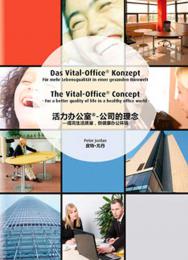It is therefore important to open yourself up to changes in order to take part creatively in life. In this sense the room design is an important medium, in a psychologically careful way, of bringing the usual security and the courage for changes harmoniously into line. A positive starting point is especially helpful for this and aids getting over so-called “blockades and complexes” faster than negative judgements.
The environment, a room, a building or a place in the landscape acts first on our feelings. We feel good, happy, agreeable, safe, joyous, or the reverse, disagreeable and anxious. When we are very active we do not necessarily become consciously aware of this feeling immediately. Nevertheless, this feeling acts associatively on our thoughts in accordance with its own laws. These change discreetly in a positive or negative direction. However, our thoughts are programme and determine our vitality. We have less strength with negative thoughts, we would prefer to withdraw. On the other hand, positive thoughts mobilize powers within us we didn’t even know we had.
The aim of a Feng Shui training is to be more consciously aware of these interactions.
Your environment is your mental feeding ground from which the food that goes into your mind is extracted. Choose your environment with care, one that is positive, one that lifts you up and gives you wings to soar.
Carl Gustav Jung developed the scientific basis for this awareness in western culture. The definition of the conscious, the personal unconscious, and the archetypal area of the collective unconscious provides some insight into the way Feng Shui techniques work. According to Jung, the goal of the lifelong process of individuation is to incorporate as much of the unconscious into consciousness as possible.
Considering the mass of the iceberg which is under water it is easily understandable which force drive us. The forces which can be mobilized by our consciousness are far to weak to overrule the immense forces of our unconscious. As a conclusion, it is advisable to deal with the principles of the unconscious in order to design a living ergonomic and efficient working environment.
Thinking pattern
Our own western very differentiating way of thinking differs enormously from the Far Eastern, more holistic view of things. Feng Shui as a traditional Chinese teaching can only be understood if you also adopt the way of thinking of Far Eastern culture.
The fundamental differences between the Western and Eastern way of thinking are:
- Transformation from inside to outside
- Balance instead of the ultimate truth
- Social responsibility before individual right
- Perception of the organism as a whole instead of the Cartesian division of spirit and matter
The division of psyche and body, and the further fragmentation of our self into separate areas (work/private life, church/sports field, feelings/self-presentation, etc.) lead to endless conflicts and confusion and frustration, metaphysically. The inner fragmentation of the Western way of thinking is also reflected in the outer - in a philosophy of life which starts from a multitude of separate objects and events which can be analyzed and used separately from each other by different groups.
However, the I (spirit) as an isolated observer, removed from outer material influences is an illusion. Spirit and matter are only different aspects of a universal unity.
Downloads:
A meticulous and holistic design of the working environment, however, can promote creativeness and significantly contribute to the wellbeing of body and mind. This design also promotes
...





 /a>
/a>
 /a>
/a>
 /a>
/a>
 /a>
/a>
 /a>
/a>
 /a>
/a>
 /a>
/a>
 /a>
/a>
 /a>
/a>
 /a>
/a>
 /a>
/a>
 /a>
/a>
 /a>
/a>
 /a>
/a>
 /a>
/a>
 /a>
/a>
 /a>
/a>
 /a>
/a>
 /a>
/a>
 /a>
/a>
 /a>
/a>
 /a>
/a>
 /a>
/a>
 /a>
/a>
 /a>
/a>
 /a>
/a>
 /a>
/a>
 /a>
/a>
 /a>
/a>
 /a>
/a>
 /a>
/a>
 /a>
/a>
 /a>
/a>
 /a>
/a>
 /a>
/a>






